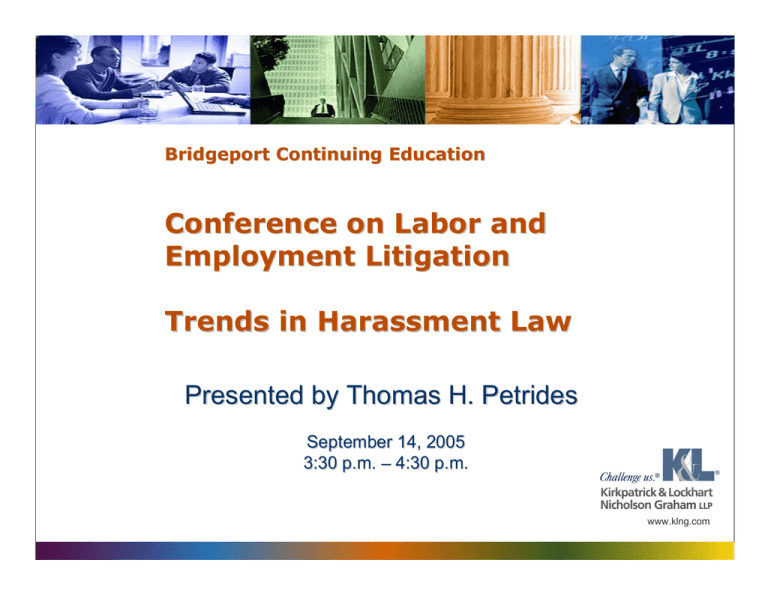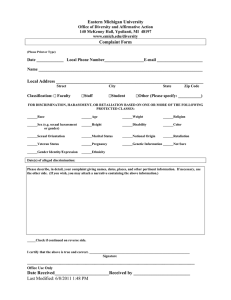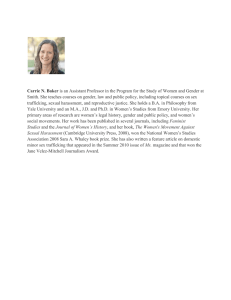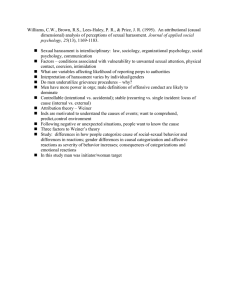
Bridgeport Continuing Education
Conference on Labor and
Employment Litigation
Trends in Harassment Law
Presented by Thomas H. Petrides
September 14, 2005
3:30 p.m. 4:30 p.m.
www.klng.com
Program Overview
AB 1825 Harassment Training
Recent Court Decisions
Claims Focusing on Company s Response
to Complaints of Harassment
2
Assembly Bill 1825
Passed in 2004
Became effective January 1, 2005
Mandates training for all supervisors on
payroll after July 1, 2005
3
Who Does Law Apply To?
Employers with 50 or more employees
- Full-time, part-time and temporary
- Includes contractors and leased employees
- Includes employees outside of California
4
What does the law require?
By 1/1/06, two hours of interactive training to
all supervisory employees on payroll as of
7/1/05
- Exception: Not required if training
provided after 1/1/03
Two hours of such training within 6 months
to all new supervisory employees
Two hours of training once every two years
after 1/1/06
5
DFEH Definition of Supervisor
Any individual having the authority to hire,
transfer, suspend, layoff, recall, promote,
discharge, assign, reward or discipline
other employees, or the responsibility to
direct them, or to adjust their grievances,
or effectively to recommend that action if
the exercise of that authority is not of a
merely routine or clerical nature, but
requires the use of independent
judgment.
6
What do these
requirements mean?
7
What is interactive?
Giving employees reading material is not
enough
Needs to be classroom, or other effective
interactive training
On-line web based training that is
interactive should be sufficient
8
What are the required
contents of the training?
9
Required Contents
Definitions of Title VII and FEHA
prohibited conduct
Prevention and correction of sexual
harassment
Remedies available to victims
Give practical examples of what
harassment, discrimination, and
retaliation might look like in the
workplace
10
Additional Provisions
Presented by trainers with knowledge and
expertise in the prevention of harassment,
discrimination and retaliation
Compliance does not insulate employer
from sexual harassment liability
Failure to comply does not in and of itself
result in claim by employee
FEHC shall issue order requiring employer
to comply
11
Recent Court Decisions
12
Recent Cases
Yanowitz v. L Oreal USA, Inc., Aug. 11,
2005, CA Supreme Court
Miller, et al. v. Dept. of Corrections, July
18, 2005, CA Supreme Court
Pennsylvania State Police v. Suder, 542
U.S. 129 (2004)
E.E.O.C. v. National Education
Association of Alaska, 2005 WL 2106164
(9th Cir. 2005)
13
Yanowitz v. L Oreal
Employee refused order of manager
- Race discrimination termination
Employee did not state reason why
Thereafter written up, onerous
performance standards imposed
Employee was not fired, went out on
leave, filed a retaliation claim
14
Two Key Determinations by
Yanowitz Court:
Court held employer should have known
why manager s order was refused ( the
Psychic factor )
Employee need not be fired or severely
disciplined to sue for retaliation
15
Miller v. Dept. of Corrections
Male supervisor had consensual affairs
with several female subordinates
Consensual partners received preferential
treatment
Subordinate females who were not
romantically involved were less favorably
treated
16
Key Determination from Miller:
Subordinate employees, both male and
female, who were less favorably treated
could maintain action for hostile work
environment sexual harassment
17
Penn. State Police v. Suder
Plaintiff complained after sexually
harassed by supervisors
2 days later, supervisors arrested plaintiff
for theft of documents her own tests
Plaintiff resigned while under interrogation
following the arrest
18
Key Determinations by Supreme Court
Court recognized claim for constructive
discharge based on severe hostile work
environment
- Must be intolerable
Company defense if effective policy for
reporting and resolving complaints and
employee failed to utilize
- But no defense for adverse employment
action such as cut in pay
19
EEOC v. NEA of Alaska
4 women subjected to hostile work
environment by male supervisor
- Yelled, swore, threatening gestures
Incidents with both men and women
- Not sex specific
He was a jerk to everybody!
20
Key Determinations by 9th Circuit
Fact that he treated men and women alike
not determinative of hostile work
environment sexual harassment
Must apply reasonable woman standard
to determine differences in subjective
effects on the sexes
Raised triable issue of fact and reversed
summary judgment for employer
21
Cases Under California Supreme
Court Review
Carter v. Calif. Dept. of Veterans Affairs
(2004)
Lyle v. Warner Brothers (2004)
22
Carter Case
Whether January 1, 2004 amendments to
FEHA making employers liable for sexual
harassment of third parties applies to
cases pending prior to that date
23
Lyle Case
Writer for Friends
Claimed that conduct during writing
meetings constituted sexual harassment
even though not directed at her
Question for Court is whether creative
necessity defense has merit sufficient to
grant summary judgment
24
Current Trends
Claims based more on how
company handles complaint and
investigation process rather than
underlying claim of harassment
itself
25
The Complaint Process
Explain process in policy
When, to whom, how to report
What happens after employee reports it
- Conduct by complaining employee
- Conduct by alleged harasser
- Conduct by Company
26
The Investigation Process
Confidentiality vs. discreet investigation
Who conducts the investigation
Who is interviewed and the circumstances
Control of the rumor mill/remaining
productive
Sensitive to privacy, emotions of those
involved
27
When the Investigation Ends
Conclusions drawn
Written report
Who gets to learn of conclusions?
What happens to the harasser and the
victim?
28
Retaliation
Subsequent termination
Changes in performance reviews,
assignment, accounts
Ostracism/isolation
29
Personal Liability of Individuals in
Sexual Harassment Claims
Who can be held liable?
Whether and when company can refuse to
defend/indemnify
Obtaining separate defense counsel
30
Questions & Answers
31



